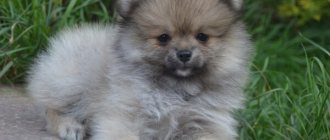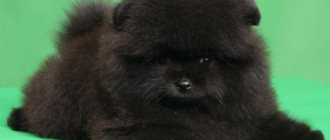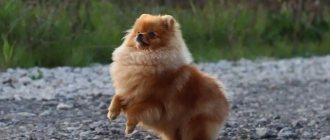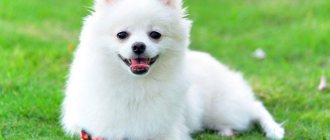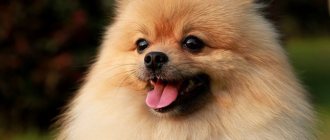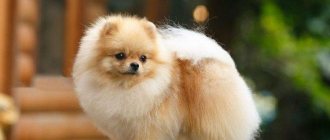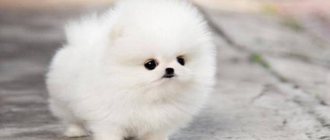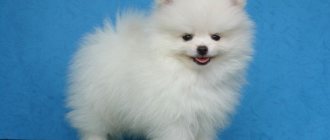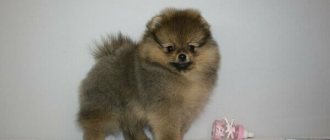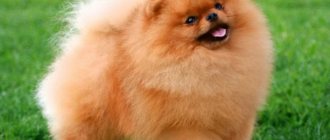The fashion for the smallest dogs has not spared Pomeranians.
Photos of adorable furry babies appear on the Internet and in the press, and it is not surprising that such dogs are in great demand.
However, some experts believe that breeding mini Pomeranians is not advisable and that they are more sickly than standard representatives of the breed.
Is this really so and is it really more difficult to keep such a pet than an ordinary Pomeranian?
Characteristics of the Pomeranian Dwarf Spitz breed
| Name | Meaning |
| Country of origin | Germany |
| Purpose | companion |
| Temperament | active |
| Constitution | miniature Pomeranian Spitz and characteristics of external qualities look impressive |
| Frame | strong, dry, muscular |
| Height | the height at the withers should be equal to the length of the body, namely 18–22 cm |
| Head | small with a pointed nose, the lobe of which is black or brown |
| Muzzle | slightly narrow, elongated at the “chanterelles” and slightly flattened at the “cubs” |
| Eyes | oval, almond-shaped, set obliquely |
| Teeth | number 42, scissor bite: upper teeth overlap lower teeth |
| Ears | triangular, erect, set high with sharp ends |
| Neck | solid medium length |
| Tail | short, set high, raised, rounded, lying on the back, folded into a ring |
| Paws | strong, straight, dark pads and nails, color exceptions may occur in cream, brown and red adult dogs |
| Movements | swift, springy |
| Wool | long guard with dense undercoat |
| Color | from pure white to black |
Lifespan
The life expectancy of a pet largely depends on care, maintenance, feeding and the number of routine examinations by a veterinarian. Compared to large breeds, Pomeranians can be called long-lived. The average life expectancy is 12-15 years. There have been cases when dogs lived longer - 18-20 years.
There are specially bred extreme types of Spitz - super-mini. Such dogs should not be able to survive, because “extreme” in the breed is not the best criterion to follow when breeding. Excessively small sizes negatively affect the functioning of organ systems. The body cannot work at full capacity with such a small size.
Origin of the breed and appearance
The Pomeranian Miniature Spitz traces its origins to the German turf dog. The predecessors of Pomeranian dogs weighed up to 23 kg and reached up to 45 cm at the withers. Spitz received its name from the Pomeranian region in East Germany, where the breed supposedly began to be bred in the 18th century. Subsequently, we randomly came to small dogs. The systematic breeding of dwarf Pomeranians began in Great Britain in the 19th century under Queen Victoria. In Europe, the queen was given a small dog, Marco, who won the heart of the great ruler. The baby turned out to be so cute that Victoria ordered to begin selection and breed a miniature dog based on this breed. At the end of the 19th century, a dwarf dog appeared, but larger than its modern relatives. The miniature orange spitz was obtained later, only in the 50s of the 20th century.
All Pomeranian representatives are conventionally divided into three subspecies depending on their appearance.
Bear type dwarf Pomeranian
It got its name because the dwarf spitz looks like a small bear cub. The animal's muzzle is shorter than that of a typical representative of the breed, and resembles a bear's. A correct rounded haircut further emphasizes the baby’s resemblance to a bear.
Fox-type dwarf orange
In appearance, they are most similar to the classic German Spitz: an elongated “fox” muzzle, long legs. And less fluffiness than the “bear cubs”.
Mini Pomeranian toy type
Transitional conditional type between bear and fox types. The muzzle is not elongated, but not too flattened either. The short-haired plush appearance will not leave anyone indifferent. The unusual location of the eyes gives the subspecies a special charm: wide apart, they make the animal look like a child’s toy. A real smooth-haired cutie.
Mating
Those who plan to buy a Pomeranian for breeding should know that mating and childbirth are difficult for the breed.
Before joining the ranks of breeders, learn everything about the breed and breeding characteristics. Difficulties are associated with:
- the size of the Miniature Spitz - often even ideal parents give birth to overly large puppies or with the dwarfism gene;
- hereditary diseases - they move from litter to litter, there are no absolutely “pure” Pomeranians: at least somewhere in the pedigree there will be a relative with a genetic pathology;
- obtaining the desired color - a specific color often has to wait for several litters, gradually deepening or lightening the color;
- directly by childbirth - a dwarf Spitz rarely gives birth on its own; a caesarean section is usually performed.
Plus, in the first years you will have to forget about profit. As a rule, 2-3 Miniature Spitz puppies are born in a litter, with a maximum of 6. And it is not a fact that all of them will be healthy and meet the standard.
Character qualities and behavioral characteristics
Pomeranians are temperamental, friendly, love walks and active games. It is not advisable for people seeking a quiet pastime to get themselves an active, cheerful prankster, such as the Pomeranian active mini dog. He will require a lot of attention and will not let the owner get bored.
From their German Spitz ancestors, Pomeranian babies inherited their protective and watchdog qualities. In an apartment, they will bark as a sign that a stranger is approaching the door. Spitz are fearless, ready to rush at any offender, regardless of his size and appearance. While walking, you will have to be careful and avoid conflict situations with other dogs.
Despite the relatively friendly nature of Spitz dogs, one must be careful when interacting with dogs and children. The cute appearance of the Shorthaired Pomeranian can be deceiving. A proud and independent character can emerge at unexpected times. A small dog will defend the boundaries of its possessions and will not allow itself to be treated like a toy.
Training
In addition to the usual, habitual training, attention should be paid to the ring preparation of the Spitz. Often owners think that there is nothing difficult here, “dumping” an unprepared dog to a handler or diligently pretending to show it in the ring themselves. Often such performances end in failure.
Success in the ring is the result of long, painstaking work by the handler. Ring preparation often takes a lot of time. In just a couple of minutes in the ring you need to demonstrate the dog in all its glory.
When preparing for exhibitions, strict measures cannot be used. This can affect the dog’s behavior: the Spitz will begin to droop its tail and ears. And he must demonstrate a lively, radiant temperament.
The dog in the ring should stand well, show its teeth and demonstrate free, easy movements. To show the dental system, you will have to spend time socializing the puppy in order to later avoid cowardice or distrustful behavior towards strangers.
Dogs perfectly sense the mood of the owner, who most often experiences it at the exhibition. It is best to give your pet to a professional handler who will be able to adequately exhibit the Spitz, showing all its advantages.
Positive and negative characteristics of a pet
Approximately the same number of minuses and pluses in the character of a nimble Pomeranian baby speaks of the adequacy and relative psychological stability of the breed.
Positive features:
- a faithful companion, ready to adapt to any habits of his owner;
- small size is convenient for keeping in an apartment and for traveling;
- an active, cheerful friend, playful and tireless;
- a brave, reliable guard with observation skills and excellent guard dog skills;
- finds contact with familiar children, behaves warily and distantly with strangers;
- neat.
Negative points:
- noisy, barks a lot,
- may show aggression towards other animals, dogs, strangers;
- impatient, restless;
- prone to certain types of diseases;
- you will have to pay attention to hair care, cutting, combing;
- prone to dominance, tries to manipulate the owner.
Without behavioral adjustments and basic training, a puppy can grow into a spoiled, selfish creature, constantly barking and attracting attention. Take the time to train your Mini and you will end up with a friendly, obedient Pomeranian dog.
Diseases
Among the genetic diseases the following are noted:
- Pathologies of the dental system. Even with a proper diet, dogs often suffer from oral diseases. It is important to regularly brush your teeth, examine your mouth, and take your dog to your veterinarian for preventive appointments. Puppies often have difficulty changing their teeth; only a veterinarian can help with this. He will remove the baby tooth so that the molar grows correctly;
- Copious discharge from the eyes is explained by anatomical features. Watery eyes begin when exposed to dust or in hot or windy weather. Your veterinarian will select the appropriate eye drops that will help eliminate the unpleasant discharge. It is not recommended to select medications on your own;
- Hypothyroidism is a pathology of the thyroid gland associated with its functioning. Among the first alarming symptoms are skin itching, obesity and alopecia;
Regular visits to the veterinary clinic should not be neglected, even if nothing bothers the dog. Some diseases can occur hidden, and sometimes a veterinarian, with the help of the necessary tests or examinations, will be able to identify the disease at the earliest stages of development.
Deworming the animal deserves serious attention. After all, the dog is in direct contact with the person. Vaccinations are required according to the vaccination plan. The rabies vaccine is required by law, because this disease is an anthropozoonosis, i.e. transmitted from animal to human. There is no cure for rabies; it is a deadly disease.
Color options
The variety of colors of Pomeranian dwarf Spitz dogs is explained by the variety of nurseries on different continents. There are many colors, not all of them are recognized by the Fédération Cynologique Internationale.
To avoid misunderstandings in determining the correct color of a Pomeranian, you should study the standard colors recognized in all countries. These are white, beige, brown, red and black. Spotted color also has its limitations. Black fawn and gray fawn Spitz dogs are allowed to participate in exhibitions. The white color should not have any spots or impurities at all. A two-color combination of different shades is included in the color standards, but a three-color color is not officially recognized. In the USA, blue, sable, brindle and merle colors are popular, which are not recognized by the FCI and Russian standards for the Pomeranian Dwarf Spitz breed.
Before purchasing a puppy, determine its purpose. A Spitz acquired for exhibition purposes and a companion for the soul require different approaches to choosing a color.
In Russia, several main colors of Pomeranian Spitz are in demand: beige, red, brown, white and black.
Beige dwarf spitz
The cream or beige color of the animal varies in shade and can only differ by half a tone from white. At the other extreme it can be dark beige, almost red or close to light brown.
Dwarf brown spitz
The brown range includes all shades of this color from light to dark chocolate. A special feature of representatives of this color is a brown nose, which is only allowed on brown Spitz. Intense rich chocolate color is valued more than light shades.
Pomeranian dwarf spitz white
The miniature Pomeranian received its main white color back in England under Queen Victoria. Animals of all other colors were bred from him. It’s simply a miracle that the snow-white color did not disappear in the selective pursuit of diversity of the breed and bringing it to micro sizes and has survived to this day in its pure form. The beautiful white Spitz has been popular since the time of Queen Victoria.
A distinctive feature of a dwarf Spitz (mini) dog is its white color without any admixture of other shades.
Wolfspitz, up to 48 cm
The dogs are medium-sized, growing up to 42-46 cm, but some individuals can stretch up to 55 cm, weighing from 25 to 30 kg. Wolfspitz , as the name suggests, are similar in color to wolves; they are silver-gray in color. Dogs are not characterized by aggression; they are very smart and intelligent.
If you want to get a Wolfspitz, remember that they cannot stand loneliness and will bark and howl loudly in an empty apartment. But these are wonderful companions for walks, because... energy flows out of them like a fountain. They love picnics, mushroom picking and any outings into nature, they are not afraid of water and can swim with their owners. Very charming and cheerful animals that can cheer up the gloomiest day.
All photos of Spitz puppies and adult dogs
Distinctive features
The differences between the standard (German) and dwarf (Pomeranian) Spitz are insignificant, the only difference being their size and health . Pomeranians, due to their compact size and not very skillful breeding work of the Middle Ages, are not distinguished by good health. German prototypes were selected naturally, and like all natives, they have much fewer health problems.
The main distinguishing features of Pomeranians:
- General form. Compact, proportional square dog. Lively, brave and inquisitive.
- Head. Small, wedge-shaped, dry. The ears are small, triangular, erect. The transition from forehead to muzzle is very pronounced. The eyes are dark brown, slightly slanted, medium in size, almost almond-shaped. The cheekbones are slightly prominent.
- Muzzle. The heads are shorter, tapering slightly towards the nose. The nose is black (or matches the shade of fur in chocolate-colored individuals). The lips fit tightly to the jaw, completely covering the lower teeth. Full set – 42 teeth, scissor bite.
- Neck. Moderate length, strong, slightly curved, giving the dog an aristocratic appearance. It widens slightly toward the withers and is covered with longer hair than the body.
- Frame. Compact, but strong for its size. The back is short, with moderately pronounced muscles. The chest is voluminous, dropped almost to the elbows, the stomach is moderately tucked. The loin is short and strong.
- Limbs. The paws are straight, with clearly visible feathering, and the metacarpus are rounded and “cat-like.” The shoulders are strong, with well-developed muscles, directed back. The thighs are strong, the knees are not convex, and the hock joint has a pronounced angle.
- Tail. Throwed over the back, set high, long to the hock joint, with abundant feathering.
Basics of maintenance and care
The decorative breed requires special maintenance conditions. Preparation should begin before purchasing a puppy. Decide in advance on a place for a miniature family member, select hygiene items.
Diet
When picking up a puppy from a breeder, you need to ask what he was fed. And for 2-3 weeks it is better to stick to the same diet, gradually transferring the baby to the food that he will eat in the future.
Miniature Spitz puppies should be fed 5-6 times a day, gradually increasing the time intervals between meals. By the age of one year, it is recommended to switch to two feedings a day. Strictly adhering to the diet,
An adult Pomeranian should receive all vitamins and minerals in full. The diet should include vegetables, protein products - meat and offal, cereals. Or switch your dog to fully balanced Premium food.
Vaccination schedule
When taking the puppy home, you need to ask the breeder about the vaccinations given. The first vaccination is carried out at two months of age. Next, you should be vaccinated according to an individual schedule developed by a veterinarian. Vaccinations against major diseases should be repeated annually: distemper, rabies, enteritis, infectious hepatitis.
Timely vaccination will keep your pet healthy and strengthen its immunity.
Predisposition to disease
Breeding a miniature dog and selection efforts led to a weakening of the animal's body. Decorative dwarf Spitz dogs are prone to eye diseases. Daily inspection of the eyes for tearing and timely care help cope with the problem.
The condition of your teeth can cause concern if you do not pay proper attention to cleaning them. Losing baby molars can sometimes cause problems for puppies. It won't hurt to get help from a veterinarian.
The jumping and restlessness of the dwarf Spitz leads to the risk of joint injury.
Walks
It is advisable to take your pet outside 3-4 times a day.
Frequent walks will help cope with your baby's excessive activity. Plus, the characteristics of a small bladder require regular exercise. If you don’t have time to walk outside for an hour or two, then puppies and adult dwarf dogs adapt to going in a litter box or using a disposable diaper.
Walks are also important for the socialization of the dwarf Pomeranian. Communication with other dogs, establishing friendly connections with strangers and animals helps to even out the dog’s character and eliminate unnecessary intolerance.
Winter walks do not cause discomfort for the Spitz: its body is protected by warm undercoat. In summer, when air temperatures are high, protect your baby from overheating by walking early in the morning, late in the evening or during the day, but choosing shady places.
In the summer, when ticks are active, it is important to treat your furry dwarf against parasites. The dense, thick coat and short stature of the dwarf Spitz are favorable conditions for ticks to penetrate the skin.
Grooming Tips
The most attractive thing about a mini Spitz is its thick, long hair that requires constant care. Combing is carried out at least 2 times a week with a slicker brush or furminator. During the shedding period, which occurs twice a year, daily brushing of the dog becomes a necessity. It is advisable to carry out the procedure not with dry, but with slightly moistened wool. Then the dog will not be bothered, and it will be easier for the owner to cope with the baby’s thick, thick clothing.
It is better to entrust the haircut to a specialist so as not to harm the pet or spoil the fluffy undercoat.
It is recommended to bathe the Pomeranian Spitz no more than once every two months using special products that keep the coat in perfect condition.
Constant attention to the thickness and cleanliness of the coat will save your pet from the unpleasant moments that arise in some individuals. If itching occurs, areas of skin with bald patches are detected, or if there is excessive hair loss, pay attention to your pet’s diet and the products used when bathing. You may need to change your diet or choose a different shampoo. It wouldn't hurt to consult a veterinarian.
Without proper care and attention, the dwarf Spitz's coat can lose its splendor.
You need to start caring for your Pomeranian baby’s coat from the very first days, teaching him to do daily procedures. Subsequently, he himself will be happy to ask you to comb him.
Home content
A beautiful fluffy orange does not take up much space, it is clean and tidy. Keeping a mini friend in an apartment or country house will not be burdensome. Carefully monitor the health of your small pet, walk him several times a day, and pay attention to the dog’s appearance.
Traveling with a dog
It is convenient to take a small dog with you on a trip. Pomeranians do not take up much space, they tolerate long journeys well, sitting comfortably in the arms of the owner. They quickly navigate unfamiliar surroundings and adapt to new conditions. You just need to take care of the dog’s toilet, food and drink.
Place to sleep
Miniature Pomeranian Spitz will not take up much space. He will sleep where the owner indicates. It will take a little persistence to train your dwarf fluffy to its place. Specialized stores sell comfortable mattresses and houses for miniature dogs. Cozy, beautiful micro-dwellings will fit into the interior of any apartment. The main thing is not to place the dog in a draft or near a heating radiator. The mobility of the dwarf orange is great; it is not suitable for keeping in a cage or other limited space. Installing a spacious enclosure with enough space for games and rest can protect the house and the most fidgety of the dangers that await him in the absence of the owner.
Health
In terms of health, the Miniature Spitz is a controversial breed. On the one hand, he is hardy, active and full of strength into old age. The average life expectancy of a Pomeranian is 14-16 years. On the other hand, the dog is fragile and susceptible to numerous hereditary and acquired pathologies. Among them:
- alopecia;
- black skin syndrome;
- congenital deafness;
- nanism;
- dislocations and subluxations of the knee and elbow joints;
- hypothyroidism;
- defects of the eyeball, retina, iris;
- hydrocephalus.
In addition, the dwarf Spitz often suffers from eczema, dermatitis, allergies, obesity, and disorders of the cardiovascular and digestive systems. Another weak point is teeth and gums. The Miniature Spitz suffers from caries, gingivitis, and complicated replacement of milk units with permanent ones.
Disease Prevention
Some owners believe that because Mini Spitz are decorative dogs; they do not need vaccinations or antiparasitic treatments. However, this opinion is wrong. Even indoor cats that have never gone outside can catch viruses, fleas or worms. Therefore, preventive measures are mandatory. So:
- a Pomeranian Spitz puppy is vaccinated against distemper, parainfluenza, leptospirosis, herpes, and rabies before the age of one year;
- adult Pomeranians are annually given comprehensive vaccinations against possible viral infections;
- Miniature Spitz dogs are treated every month for blood-sucking parasites, and once every 3 months for helminths.
Boy and girl: differences in height and weight
The differences in height and weight between a boy and a girl in Pomeranian dogs are not noticeable. Everything is hidden by fur.
The Spitz male is more powerful, with more developed muscles. The height at the withers of an adult dwarf dog reaches 20-22 cm, which corresponds to the length of the body from neck to tail. Some individuals can grow up to 25 cm.
The weight of animals ranges from 1.3 to 3.2 kg. The indicator depends on genetics. To a small extent, it can be regulated by diet and physical activity.
Pomeranian dwarf dogs weighing up to two kilograms are allowed for exhibitions, regardless of whether they are male or female. Deviations up and down are not allowed.
The Miniature Pomeranian looks like a small puppy and an adult.
Socialization
Mini Spitz are natural extroverts. They are friends with everyone: children, dogs, cats. Even parrots and guinea pigs are friends in the eyes of Pomeranians, not prey.
At the same time, the Miniature Spitz will tire of all pets with its obsession. He pulls cats by the tails, pulls out feathers from birds, and takes carrots from rabbits. But he doesn’t do this out of malice: this is how he plays.
The only problem arises between the males. Pomeranians are dominant, consider themselves big dogs, and do not know how to compare their own strength with that of their opponent. They will even get into a fight with a Cane Corso or Alabai. Confrontations end with injuries or death of the little brave men. That’s why they don’t take their eyes off the “Napoleons” while walking.
It is not advisable to bring children under 6 years of age to a house where Pomeranians live. Kids don’t understand how to properly handle animals and can literally squeeze a fragile dog to death.
But for children 8-10 years old, the dog will become a wonderful companion. She loves children and is ready to play with them for hours and run around the street. The only thing is that Miniature Spitz dogs with behavioral problems are not left alone with children. If a psychologically balanced Pomeranian does not offend a child, then an ill-mannered dog may snap or bite the baby.
Pomeranians are wary of strangers. But if strangers do not threaten them or their owner, they are quickly accepted into the “flock.” And if you treat the dogs with a treat and praise them, their hearts will be won.
Photo of a white dwarf Pomeranian Spitz
A little historical background
Without a doubt, dwarf Spitz can be considered one of the oldest breeds in the world! At the same time, these representatives acquired their decorative outlines no earlier than the 18th century. And the Pomeranian Spitz owes its name to a small provincial region of the same name, which is located in Germany - Pomerania.
Tellingly, the ancestors of these representatives were much larger in size than their modern descendants. And at that time these were sled dogs and hunting dogs. Their weight could reach up to 15 kg!
Having moved from northern latitudes to an area with more suitable and comfortable climatic conditions, Pomeranians acquired excellent guard skills. They were even entrusted with the responsibility of guarding livestock.
Choosing a puppy
Choose a dog only from trusted breeders. In order not to make a mistake with the color, it is better to buy a puppy at the beginning of the first molt, namely after 4 months. Then the final colors of black, black fawn, grey, red and brown puppies will be visible. When contacting a nursery, you can be sure that a white Pomeranian dwarf (mini) Spitz will not grow into a puppy of an unknown breed.
Take a look at the dogs on offer and focus your selection on active, playful kids.
Price range
The cost of a puppy depends on the color, length of the pedigree and the availability of documents. Puppies of unofficial colors are cheaper than their relatives of official colors. Pomeranian Spitz babies without documents are sold for approximately 10-15 thousand rubles. With documents, a puppy costs much more - from 30 to 80 thousand rubles. Sometimes the price reaches 100 thousand. When purchasing, contact only responsible breeders who guarantee the purchase of a healthy orange and the authenticity of the papers provided.
Choosing a nickname
We will not touch on the official names of Pomeranians, which are given to them by breeders according to certain rules. They are recorded in stud books, under which dogs participate in exhibitions, but they are too long and pretentious. Much more convenient in everyday life are short, sonorous nicknames that are invented by the owner himself, that is, you. Nicknames should correspond to the pet’s perky character and contain rolling, ringing sounds. Avoid names with sibilants and sibilants at the beginning.
| Nicknames for Spitz girls: | Amalia, Ishtar, Athena, Bonya, Coco. |
| Suitable names for male dogs: | Outstanding personalities (Cyrus, Zeus) and even ordinary male names (Thomas, Grisha, Tim). If the pet's official name can be abbreviated, use the short version (Seb for Sebastian, Eddie for Edward). |
Old age is no joy!
However, mobility, playfulness and other qualities are preserved only until old age. As a rule, dogs of this breed can live a relatively long life - from 12 to 15 years. At an age comparable to extreme old age, dogs become calmer and slower. What can I say, the years take their toll on dogs too!
It is becoming more and more difficult for the old man to get on his feet, climb steps, and even perform some basic trick. He spends most of his time alone. The dog's character also undergoes certain changes. It is very difficult for a dog to endure separation from his owner, and when he is left alone, his soul becomes anxious. When alone for a long time, he begins to bark, whine or howl.
Yes, old age is rarely easy for any person to bear. And what can we say about such cute animals with a delicate and vulnerable psyche?!
